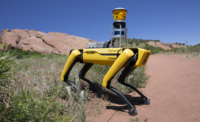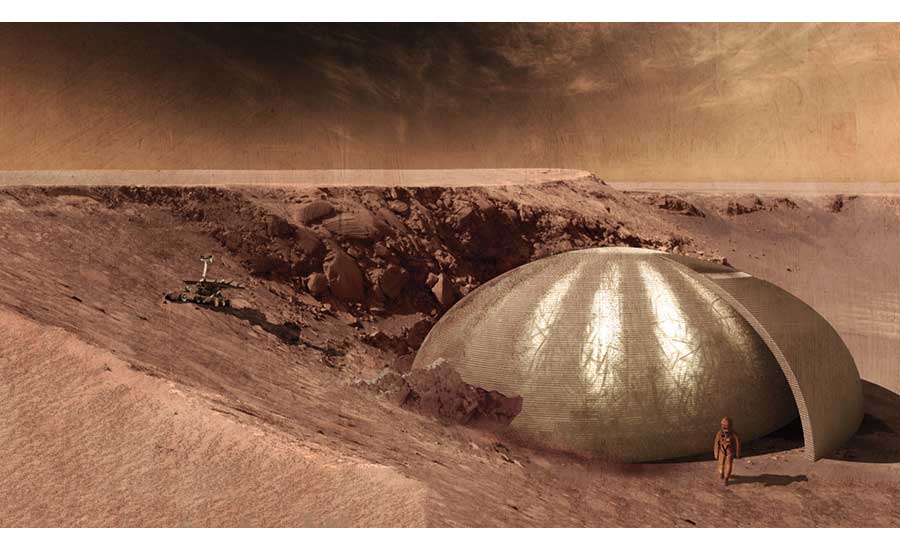ENR FutureTech Special Report
3D Printing Buildings on Mars Has Lessons for Back on Earth

A concept sketch from an early phase of the NASA Mars 3D-Printed Habitat Challenge envisions a robot-built structure.
IMAGE COURTESY NASA

Teams from around the world tried out their 3D-printing rigs to see if they could build self-supporting structures using only materials similar to those found on the surface of Mars.
PHOTO COURTESY NASA

Teams from around the world tried out their 3D-printing rigs to see if they could build self-supporting structures using only materials similar to those found on the surface of Mars.
PHOTO COURTESY NASA

3D-printed concrete can achieve remarkably consistent distribution, as seen in these samples from CTL Group.
PHOTO BY JEFF RUBENSTONE / ENR

3D-printed materials are now strong enough to form load-bearing beams and columns, with strengths comparable to traditional concrete mixes.
PHOTO: NASA

Competitors in the challenge had to produce structural shapes out of the Martian regolith to be load-tested for structural strength.
PHOTO BY JEFF RUBENSTONE / ENR

Competitors in the challenge had to produce structural shapes out of the Martian regolith to be load-tested for structural strength.
PHOTO BY JEFF RUBENSTONE / ENR

Contour Crafting is aiming to have a concrete-printing robot rig ready for market by early 2018.
PHOTO COURTESY CONTOUR CRAFTING

Branch Technology’s 3D-printed Mars dome performed the best in load tests.
PHOTO: NASA

Co-CEO Platt Boyd shows off the firm’s lattice-style, 3D-printed wall segment with foam filler. This carbon-fiber lattice can support 3,000 lb of pressure by itself, but filled in it can bear 6,000 lb. Shrink the lattice cell size and that jumps to 10,000 lb.
PHOTO: JEFF RUBENSTONE / ENR

Branch Technology’s 3D-printed Mars dome performed the best in load tests.
PHOTO: NASA













At a test facility in rural Illinois, engineers fabricate structural segments for buildings. But instead of using typical assembly techniques, here at this dirt-floor arena with tightly controlled conditions, teams employ robotic nozzles to extrude domes, beams and cylinders using material chosen for its similarity to the regolith found on the surface of the planet Mars.
The activity comprises part of the 3D-Printed Mars Habitat Design Challenge, which focuses on how to go about building structures on Mars to eventually house human explorers. It’s a component of the NASA Centennial Challenges, a contest series that solicits the public to solve the practical problems of future space exploration. The third phase of the challenge, underway now, focuses on creating stable structural members using an additive manufacturing process based on basaltic rock geologically similar to what is found on Mars.
“This leg of the competition is focused on the materials, specifically the indigenous Mars regolith,” explains Tony Kim, deputy program manager for NASA’s Centennial Challenge. “All of the teams are approaching it differently.” Previous phases of the challenge focused on conceptual designs for habitats and proof-of-concept 3D-printed shapes. But this showdown emphasizes pure structural strength, as the 3D-printed cylinders, beams and domes will be subjected to loading until they fail.
Related Articles:
Material Researchers 'Painting' in 3D at Northwestern Lab
Caterpillar Using 3D-Printed Parts on Heavy Equipment, With Little Fanfare
Strict rules on what can be used in the printing material complicate the task. Teams are supposed to use about two-thirds regolith, with some additives and recycled materials to help it flow and cure, but are penalized for using anything that would be difficult to extract or ship to Mars, such as water.
“The challenge forces you to think about using less water, about recycling everything you bring. On Mars you’ll have to be the best recycler in the universe to survive,” says Monsi Roman, Centennial Challenge program manager at NASA. “But all of the lessons learned in that process can bring some interesting benefits for applications back on Earth.”
The Mars habitat challenge, run by NASA in cooperation with Bradley University in Peoria, Ill., is sponsored by equipment manufacturer Caterpillar, which provided the use of its demonstration and testing facility in Edwards, Ill. The other major sponsor, Silicon Valley venture capital firm Brick & Mortar Ventures, focuses on investing in technology related to the construction industry.
“Space construction is a great field—it gets people of all different backgrounds fired up,” says Curtis Rodgers, vice president at Brick & Mortar Ventures. “The Centennial Challenge is a great way to get all sorts of people pitching ideas that can eventually be commercialized: academic research labs, mad scientists in garages and early-stage companies, which are all an important part of this larger engineering community.”
Five teams qualified for this round of the challenge, and three made it to Caterpillar’s demonstration center to compete, from Aug. 23 to Aug. 26, for the top prize. A student team from Singapore and a team from the material research lab CTL Group were unable to compete. So, it came down to two university teams and a private venture, furiously printing the cylinders, beams and domes under the watchful eyes of NASA judges.
The academic entrants included a Penn State team, whose robotic arm worked with a concrete-like admixture that required adequate time to cure. Moon X Construction, from Hanyang University in Seoul, South Korea, brought in a gantry-mounted robotic nozzle that could move freely along rails but encountered performance issues during setup and was unable to compete in all of the categories. Still, the team worked diligently to debug its custom machine, which had never previously printed at such a large scale.
The Moon X Construction team is led by Tai Sik Lee, PE, a professor at Hanyang University and the president of the Korea Institute of Civil Engineering and Building Technology. “My background is civil engineering, but I think I’m the first space civil engineer,” he says with a laugh. While Lee’s team had to improvise solutions for its stubborn robot, he thinks this adaptability and resourcefulness will be crucial for engineers who build beyond Earth. “There are efforts going on to start mining asteroids or the Moon in the next five to 10 years, and that means space construction will have to be ready.”
The final team at work on the arena floor had a much different vibe from the swarms of graduate students at the other stalls. Printing with a robotic arm inside a sealed trailer, a team-up between 3D-printing startup firm Branch Technology and architectural design firm Foster + Partners pushed the limits of its free-form printing approach that already has seen some highly visible demonstration projects.
While it has been around for only a few years, Branch Technology has drawn attention in the design community for its 3D-printing robotic arm, which can produce elaborate, lattice-like structures that retain a great deal of structural strength with a minimum of material. The company’s work has been seen in art installations (ENR 9/26/15 p. 94), including a SHoP Architects-designed pavilion at the 2017 Miami Design exhibition, but it has yet to be used in real construction.
“We’re targeting strength-to-weight ratios, going for very strong but lightweight,” says Platt Boyd, Branch co-CEO. While the forms it prints for the NASA challenge are fully solid to maximize strength, the company typically focuses on its lattice patterns. “We’re printing structural wall segments with foam infilling that is stronger than wood-stud construction,” says Boyd.
Foster + Partners involvement in a Martian construction project is not as unusual as it sounds, according to Marc Guberman, a company partner. “It takes real examples to advance technology, and this competition is really pushing the boundaries of what 3D printing can do right now,” he observes. “Branch’s robot, the way it dances around a space, opens up possibilities for new designs.”
Meanwhile, Back on Earth
While the NASA challenge looks for tomorrow’s 3D-printing solutions, some engineers say the technology can be employed today for commercial construction. Behrokh Khoshnevis, a professor at the University of Southern California, has been developing large-scale 3D-printing technology for over two decades, creating a system around a concrete mix similar to what is commonly used in construction today. His robots can extrude quick-setting concrete into walls sections, columns and other common shapes that would normally require elaborate formwork and extended curing times to cast on site.
“3D-printed habitats are real. All the pieces are coming into place for a trip to Mars.”
– Don Thomas, NASA Astronaut
While Khoshnevis has demonstrated the feasibility of printing building structures out of concrete in the past (ENR 12/16/13 p. 24), his technology has not been commercialized until now. Earlier this year, Doka Ventures, the investment arm of the corporate parent of global formwork giant Doka, purchased a 30% stake in Contour Crafting, a private venture set up by Khoshnevis. The company plans to unveil a commercially available robot capable of 3D-printing concrete buildings by the first quarter of 2018.
Contour Crafting plans to manufacture concrete-printing robots weighing less than 800 lb each, with reaches of 24 ft to 40 ft. According to Khoshnevis, the devices will be able to accept standard concrete with only slight adjustments to the admixture. “We use certain admixtures to increase the fluidity of the concrete and have to have concrete that cures a little faster. But, basically, it’s the same performance,” he says.
“The first order is already on the books,” says Contour Crafting CTO Werner H. Bittner, who is also a member of Doka Ventures executive board. For Khoshnevis, this move is long overdue. “On the materials side, the problem is solved. We just need to develop new hardware in the nozzle that is a bit more forgiving.” But by next year, they will be able to print the entire shell of a building, up to 1,500 sq ft, he told ENR.
Results Are In, But Work Remains
As beams and cylinders came off the printing surfaces on the last days of the Mars habitat challenge, engineers from Amec Foster Wheeler oversaw the load-testing procedures. The 3D-printed shapes were put in equipment usually used to certify portland-cement-based concrete shapes. For the purposes of the contest, the beams were tested to the ASTM C778 standard and the cylinders to the ASTM C39 standard.
“The flexual strength in one beam we tested exceeds what we typically would see in a portland cement type of concrete,” says Don Chandler, PE, quality management program director at Amec Foster Wheeler. During testing, the beam, from the Branch Technology-Foster + Partners team, withstood 31,290 lb of force before failing. “It kind of delaminated and failed slowly, which is what you want—gives you time to get people out of a structure, even on Mars,” says Chandler. “Looking at all this, I can really see potential for future construction on this world.”
Judges put the 3D-printed domes to the test on the last day of the challenge. Made of unreinforced concrete formed in the same standard design, domes were tested first, failing at a load of approximately 1,090 kg, or about 2,403 lb.
Moon X Construction’s technical problems prevented the team from printing a dome in time for testing. The Penn State team had struggled to cure its dome fast enough to meet the deadline, resorting to using formwork during the print cycle. Judges allowed this as long as the robot could remove the formwork unaided. Under the force of a hydraulic excavator attachment before a crowd of onlookers, Penn State’s dome gave out with a loud crack under a load of 792 kg, or 1,746 lb.
The Branch Technology-Foster + Partners dome was next. Aside from some disconcerting creaking noises, it maintained its structural strength until failing at 1,694 kg, or 3,734 lb. As the winner, Branch Technology and Foster + Partners took home $250,000. The Penn State team received $150,000 for second place. But for the teams competing and the organizers watching over it, the contest was about far more than handing out oversized novelty checks.
“If you can build lighter, faster and stronger on site—with an order of magnitude more of design freedom—as an architect I’d be lining up for days to be building with that method,” said Boyd after the final tests.
Foster + Partners’ Guberman added, “3D printing has inherent constraints, but those constraints—from a designer standpoint—are helpful because they end up yielding an interesting solution you couldn’t think of in advance.”
“This isn’t just some futuristic, down-the-road idea where we don’t know how to do it,” says Don Thomas, a NASA astronaut who observed the final dome tests. “We’re working on the launch-system rockets right now, and these 3D-printed habitats are real. All the pieces are coming into place for a trip to Mars.”















